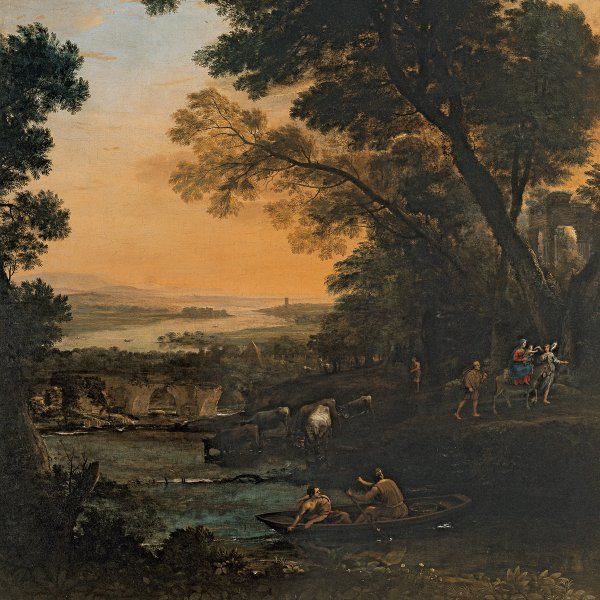Claude Lorraine
Chamagne, 1604/5-Rome, 1682
A 17th-century French painter active in France, Claude Gellée, known as Claude Lorraine, was born in 1604 or 1605 in Chamagne, a small village in the independent duchy of Lorraine. He was orphaned at an early age and moved to Freiburg im Breisgau with his eldest brother. Around 1613 he travelled to Rome and shortly afterwards to Naples, where he studied for two years with the landscape painter Gottfried Wals. Claude then returned to Rome and completed his training in the studio of Agostino Tassi. From 1620 he spent time living in Naples, Nancy and Venice but in 1627 is again documented in Rome where he remained for the rest of his life.
In the 1630s Claude began to achieve considerable fame as a landscape painter and by around 1638 had a large number of commissions and clients, including Pope Urban VIII, Philip IV of Spain, Cardinal Bentivoglio and other ecclesiastical and aristocratic figures. Claude became a celebrated artist and was widely imitated during his own lifetime. For this reason he created a pictorial record of his compositions in a book known as the Liber Veritatis (British Museum, London). In it he drew reproductions of 200 of his paintings and annotated the names of their owners and dates of sale.
In addition to the influence of his master Tassi, Claude’s work reveals the importance of Flemish and Dutch painting. Claude developed a type of landscape that captured the truth and beauty of nature and he was, together with Poussin, of outstanding importance for French Baroque painting. Claude’s views, based on the Roman Campagna, often include pastoral scenes and are idealised depictions of nature in which order and beauty prevail. In these compositions the artist focused on atmospheric effects and the changing light at the different times of the day. His work remained highly influential until the 19th century and was fundamental for the generation of painters from Turner to Monet.
In the 1630s Claude began to achieve considerable fame as a landscape painter and by around 1638 had a large number of commissions and clients, including Pope Urban VIII, Philip IV of Spain, Cardinal Bentivoglio and other ecclesiastical and aristocratic figures. Claude became a celebrated artist and was widely imitated during his own lifetime. For this reason he created a pictorial record of his compositions in a book known as the Liber Veritatis (British Museum, London). In it he drew reproductions of 200 of his paintings and annotated the names of their owners and dates of sale.
In addition to the influence of his master Tassi, Claude’s work reveals the importance of Flemish and Dutch painting. Claude developed a type of landscape that captured the truth and beauty of nature and he was, together with Poussin, of outstanding importance for French Baroque painting. Claude’s views, based on the Roman Campagna, often include pastoral scenes and are idealised depictions of nature in which order and beauty prevail. In these compositions the artist focused on atmospheric effects and the changing light at the different times of the day. His work remained highly influential until the 19th century and was fundamental for the generation of painters from Turner to Monet.




